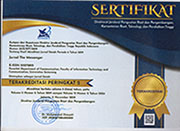How Covid-19 Pandemic Reshaped Cultural Environment in Italy and Ukraine: Facebook Content Analysis
Abstract
Keywords
Full Text:
PDFReferences
Beugelsdijk, S., Kostova, T., & Roth, K. (2017). An overview of Hofstede-inspired country-level culture research in international business since 2006. Journal of International Business Studies, 48(1), 30 47. https://doi.org/10.1057/s41267-016-0038-8
Blyznyuk, T., & Lepeyko, T. (2016). Profile of modern Ukrainian manager. Proceedings Cross-Cultural Business Conference 2016, School of Management, Steyr Campus, 256-266.
Bottega Verde. (n.d.). Home [Facebook page]. Facebook. Retrieved May 8, 2020, from https://www.facebook.com/BottegaVerde/
Cheng, W., Hung, L., & Chien, C. (2011). Cultural diversity and information and communication impacts in language learning. International Education Studies, 4(2), 111-115. https://doi.org/10.5539/ies.v4n2p111
Ä iburien ¨, J., GuÅ¡Äfinskien ¨, J., & Orehova, T. (2007). The Changes of Cultural Values: Lithuanian and Ukrainian Case. Socialiniai tyrimai [Social Research], 2(10), 33-38.
Clark, T. (2003). Book Reviews. Journal of Marketing, 67(2), 151-153, https://doi.org/10.1509/jmkg.67.2.151.18611
Conad. (n.d.). Home [Facebook page]. Facebook. Retrieved May 8, 2020, from https://www.facebook.com/Conad/
Croucher, S.M. (2011). Social networking and cultural adaptation: A theoretical model. Journal of International and Intercultural Communication, 4(4), 259 264. https://doi.org/10.1080/17513057.2011.598046
Dadgar, M., Vithayathil, J., & Osiri, J.K. (2017). Social Media Usage and Cultural Dimensions: An Empirical Investigation. Proceedings of the 50th Hawaii International Conference on System Sciences. http://hdl.handle.net/10125/41426
De Long, D.W., & Fahey, L. (2000). Diagnosing cultural barriers to knowledge management. Academy of Management Executive, 14(4), 113-127. https://doi.org/10.5465/ame.2000.3979820
Ess, C., & Sudweeks, F. (2006). Culture and computer-mediated communication: Toward new understandings. Journal of Computer-Mediated Communication, 11(1), 179 191. https://doi.org/10.1111/j.1083-6101.2006.tb00309.x
Eva. (n.d.). Home [Facebook page]. Facebook. Retrieved May 8, 2020, from https://www.facebook.com/EVA.dp.ua/
Ford, D.P., & Chan, Y.E. (2003). Knowledge sharing in a multicultural setting: a case study, Knowledge Management Research and Practice, 1(1), 11-27. https://doi.org/10.1057/palgrave.kmrp.8499999
Fu, W.W., & Govindaraju, A. (2010). Explaining global box-office tastes in Hollywood films: Homogenization of national audiences' movie selections. Communication Research, 37(2), 215-238. https://doi.org/10.1177%2F0093650209356396
Garcia-Gavilanes, R., Quercia, D., & Jaimes, A. (2013). Cultural dimensions in Twitter: Time, individualism and power. Proceedings of the 7th International AAAI Conference on Weblogs and Social Media (ICWSM). https://www.aaai.org/ocs/index.php/ICWSM/ICWSM13/paper/view/6102/6358
Gokmen, Y., Baskici, C., & Ercil, Y. (2021). The impact of national culture on the increase of Covid-19: A cross-country analysis of European countries. International Journal of Intercultural Relations, 81, 1-8. https://doi.org/10.1016/j.ijintrel.2020.12.006
Gravili, G. (2016). Sharing Knowledge through Social Media: The Influence of National Cultures. Proceedings of the 2016 International Conference on Artificial Intelligence: Technologies and Applications (ICAITA 2016). https://doi.org/10.2991/icaita-16.2016.34
Hajro, A., Gibson, C.B., & Pudelko, M. (2017). Knowledge exchange processes in multicultural teams: Linking organizational diversity climates to teams' effectiveness. Academy of Management Journal, 60(1), 345-372. https://doi.org/10.5465/amj.2014.0442
Hofstede Insights (n.d.). Geert Hofstede Country Comparison Tool. Retrieved May 8, 2020, from https://www.hofstede-insights.com/country-comparison/italy,ukraine/
Hofstede, G. & Bond, M.H. (1988). The Confucius connection: from cultural roots to economic growth. Organizational Dynamics, 16(4), 4-21. https://doi.org/10.1016/0090-2616(88)90009-5
Hofstede, G. (1980). Culture's consequences: international differences in work-related values. Sage Publications.
Hofstede, G. (1991). Cultures and organizations: software of the mind. McGraw-Hill.
Hofstede, G. (2001). Culture's consequences: comparing values, behaviors, institutions and organizations across nations (2nd ed.). Sage Publications.
Hofstede, G., Hofstede, G.J. & Minkov, M. (2010). Cultures and organizations: software of the mind (3rd ed.). McGraw-Hill.
House, R.J., Hanges, P.J., Javidan, M., Dorfman P.W. & Gupta V. (2004). Culture, Leadership, and Organizations. The GLOBE Study of 62 Societies. Sage Publishing.
Huanga, S., & Crotts, J. (2019). Relationships between Hofstede's cultural dimensions and tourist satisfaction: A cross-country cross-sample examination. Tourism Management, 72, 232-241. https://doi.org/10.1016/j.tourman.2018.12.001
Huynh, T.L.D. (2020). Does culture matter social distancing under the COVID-19 pandemic? Safety Science, 130, 104872. https://doi.org/10.1016/j.ssci.2020.104872
Italo Treno. (n.d.). Home [Facebook page]. Facebook. Retrieved May 8, 2020, from https://www.facebook.com/ItaloTreno/
Johnston, K., & Johal, P. (1999). The Internet as a virtual cultural region: Are extant cultural classification schemes appropriate? Internet Research, 9(3), 178 186.
Kirkman, B.L., Lowe, K.B., & Gibson, C.B. (2006). A quarter century of Culture's Consequences: A review of empirical research incorporating Hofstede's cultural value framework. Journal of International Business Studies, 37(3), 285 320. https://doi.org/10.1057/palgrave.jibs.8400202
Kochkina, N. (2019). "Dynamics of PESTLE Factors of Ukrainian Market Environment", in Bele, D., Weis, L., Maher, N. (Eds.), Sustainable Development under Conditions of European Integration, Part 1, Ljubljana School of Business, pp. 250-265. https://www.researchgate.net/publication/333602437_DYNAMICS_OF_PESTLE_FACTORS_OF_UKRAINIAN_MARKET_ENVIRONMENT
Krishen, A.S., Berezan, O., Agarwal, Sh., Kachroo, P., & Raschke, R. (2021). The digital self and virtual satisfaction: A cross-cultural perspective. Journal of Business Research, 124, 254-263. https://doi.org/10.1016/j.jbusres.2020.11.056
Laitinen, E.K., & Suvas, A. (2016). Financial distress prediction in an international context: Moderating effects of Hofstede's original cultural dimensions. Journal of Behavioral and Experimental Finance, 9, 98-118. https://doi.org/10.1016/j.jbef.2015.11.003
Lee-Won, R.J., Shim, M., Joo, Y.K., & Park, S.G. (2014). Who put the best "face" forward on Facebook?: Positive self-presentation in online social networking and the role of self-consciousness, actual-to-total Friends ration, and culture. Computers in Human Behavior, 39, 413 423. https://doi.org/10.1016/j.chb.2014.08.007
Levine, R. (2006). A Geography of Time: The Temporal Misadventures of a Social Psychologist or How Every Culture Keeps Time Just a Little Bit Differently. University Press.
Lo, K.D., Waters, R.D., & Christensen, N. (2017). Assessing the applicability of Hofstede's cultural dimensions for Global 500 corporations' Facebook profiles and content. Journal of Communication Management, 21(1), 51-67. https://doi.org/10.1108/JCOM-04-2016-0021
Marcus, A., & Gould, E.W. (2000). Crosscurrents: Cultural Dimensions and Global Web User Interface Design. Interactions, 7(4), 32-46. https://doi.org/10.1145/345190.345238
Mazanec, J.A., Crotts, J.C., Gursoy, D., & Lu, L. (2015). Homogeneity versus heterogeneity of cultural values: An item-response theoretical approach applying Hofstede's cultural dimensions in a single nation. Tourism Management, 48, 299-304. https://doi.org/10.1016/j.tourman.2014.11.011
McEwan, B. & Sobre-Denton, M. (2011). Virtual cosmopolitanism: Constructing third cultures and transmitting social and cultural capital through social media. Journal of International and Intercultural Communication, 4(4), 252 258. https://doi.org/10.1080/17513057.2011.598044
Minkov, M. (2007). What makes us different and similar: A new interpretation of the World Values Survey and other cross-cultural data. Klasika i Stil.
Minkov, M., Kaasa, A. (2021). A Test of the Revised Minkov-Hofstede Model of Culture: Mirror Images of Subjective and Objective Culture across Nations and the 50 US States. Cross-Cultural Research, 55(2-3), 230 281. https://doi.org/10.1177/10693971211014468
Na, J., Kosinski, M., & Stillwell, D.J. (2015). When a new tool is introduced in different cultural contexts: Individualism-collectivism and social network on Facebook. Journal of Cross Cultural Psychology, 46(3), 355 370. https://doi.org/10.1177/ 0022022114563932
Nova Poshta. (n.d.). Home [Facebook page]. Facebook. Retrieved May 8, 2020, from https://www.facebook.com/nova.poshta.official/
Orlikowski, W.J., & Barley, S.R. (2001). Technology and Institutions: What Can Research on Information Technology and Research on Organizations Learn From Each Other? MIS Quarterly 25(2), 145-165. https://doi.org/10.2307/3250927
Pantano, E., Priporas, C., Devereux, L., & Pizzi, Gabriele (2021). Tweets to escape: Intercultural differences in consumer expectations and risk behavior during the COVID-19 lockdown in three European countries. Journal of Business Research, 130, 59-69. https://doi.org/10.1016/j.jbusres.2021.03.015
Picoto, W.Ng, & Pinto, I. (2021). Cultural impact on mobile banking use A multi-method approach. Journal of Business Research, 124, 620-628. https://doi.org/10.1016/j.jbusres.2020.10.024
Porter, M.E. (2001). Strategy and the Internet. Harvard Business Review, March 2001. https://www.gospi.fr/IMG/pdf/strategy-and-the-internet-porter-hbr-2001.pdf.
Prakash, C.D., & Majumdar, A. (2021). Analyzing the role of national culture on content creation and user engagement on Twitter: The case of Indian Premier League cricket franchises. International Journal of Information Management, 57, April 2021, 102268. https://doi.org/10.1016/j.ijinfomgt.2020.102268
Rajkumar, R.Ph. (2021). The relationship between measures of individualism and collectivism and the impact of Covid-19 across nations. Public Health in Practice, 2, 100143. https://doi.org/10.1016/j.puhip.2021.100143
Richardson, R.M., & Smith, S.W. (2007). The influence of high/low context culture and power distance on choice of communication media: Students' media choice to communicate with professors in Japan and America. International Journal of Intercultural Relations, 31(4), 479-501. https://doi.org/10.1016/j.ijintrel.2007.01.002
Rosen, L.D., Lim, A., Carrier, M., & Cheever, N.A. (2010). An Empirical Examination of the Educational Impact of Text Message-Induced Task Switching in the Classroom: Educational Implications and Strategies to Enhance Learning, in Psicolog a Educativa, 17(2), 163-17. https://doi.org/10.5093/ed2011v17n2a4
Rozetka. (n.d.). Home [Facebook page]. Facebook. Retrieved May 8, 2020, from https://www.facebook.com/rozetka.ua/
Shapoval, V., Hagglund, P., Pizam, A., Abraham, V., Carlback, M., Nygren, T., & Smith, R.M. (2021). The Covid-19 pandemic effects on the hospitality industry using social systems theory: A multi-country comparison. International Journal of Hospitality Management, 94, 102813. https://doi.org/10.1016/j.ijhm.2020.102813
Shestakovsky, O. (2014) Where are the cultural differences between the regions? Experience of the application of the methodology of G. Hofstede in Ukraine. Proceedings of conference: The Great Wars, the Great Transformations: Historical Sociology of the 20th Century. Kyiv, November 27-28, 2014, 1914- 2014.
Shiwei, H., & Zhang, Yu. (2021). Covid-19 pandemic and firm performance: Cross-country evidence. International Review of Economics & Finance, 74, 365-372. https://doi.org/10.1016/j.iref.2021.03.016
Shuter, R. (2011). Introduction: New media across cultures €”prospect and promise. Journal of International and Intercultural Communication, 4(4), 241 245. https://doi.org/10.1080/17513057.2011.598041
Socialbakers (2018a, August). August 2018 Social Marketing Report Ukraine. https://www.socialbakers.com/resources/reports/ukraine/2018/august
Socialbakers (2018b, August). August 2018 Social Marketing Report Italy. https://www.socialbakers.com/resources/reports/italy/2018/august/
Socialbakers (2020a, April). April 2020 Social Marketing Report Ukraine. https://www.socialbakers.com/resources/reports/ukraine/2020/april
Socialbakers (2020b, April). April 2020 Social Marketing Report Italy. https://www.socialbakers.com/resources/reports/italy/2020/april
Taras, V., Steel, P., & Kirkman, B.L. (2012). Improving national cultural indices using a longitudinal meta-analysis of Hofstede's dimensions. Journal of World Business, 47(3), 329-341. https://doi.org/10.1016/j.jwb.2011.05.001
Taras, V., Steel, P., & Kirkman, B.L. (2016). Does country equal culture? Beyond geography in the search for cultural boundaries. Management International Review, 56(4): 455 487. http://dx.doi.org/10.1007/s11575-016-0283-x
Urban, G. (2005). Don't just relate €”Advocate! A blueprint for profit in the era of customer power. Wharton School Publishing.
Wackowski, K. & Blyznyuk, T. (2017). Modern Ukrainian and Polish business cultures: G. Hofstede's classification. Economic Annals-XXI, 165(5-6), 71-74. https://doi.org/10.21003/ea.V165-15
Wang, Y. (2021). Government policies, national culture and social distancing during the first wave of the Covid-19 pandemic: International evidence. Safety Science, 135, 105138. https://doi.org/10.1016/j.ssci.2020.105138
Webster, G.D., Howell, J.L., Losee, J.E., Mahar, E.A., & Wongsomboon, V. (2021). Culture, Covid-19, and collectivism: A paradox of American exceptionalism? Personality and Individual Differences, 178, 110853. https://doi.org/10.1016/j.paid.2021.110853
Wilson, M. (2010). An exploration of network and community theory and technosocial forms. Information, Communication & Society, 13(5), 747 764. https://doi.org/10.1080/13691180903271572
DOI: http://dx.doi.org/10.26623/themessenger.v13i3.2780
Refbacks
- There are currently no refbacks.
Copyright (c) 2021 Jurnal The Messenger
View My Stats [Jurnal The Messenger] is an International Scientific Journal, Published by the Department of Communication, Faculty of Information Technology and Communication, Universitas Semarang (Central Java, Indonesia). It is licensed under a Creative Commons Attribution 4.0 International License.



_11.jpg)




_BARCODE.jpg)
_BARCODE1.jpg)


5.png)










2.png)





